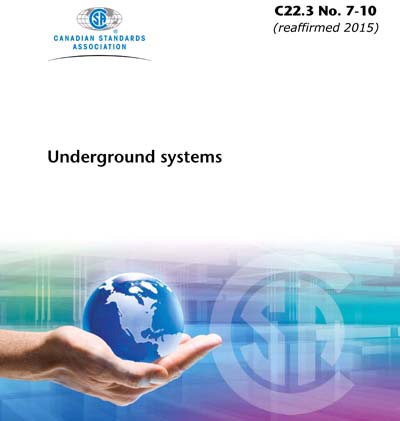Historical
CAN/CSA C22.3 No. 7-2010 (R2015)
CAN/CSA-C22.3 NO. 7-10 - Underground systems
Update #1 was published as notification that this is now a National Standard of Canada.To download any updates and/or register for email notification of future updates. click here.
Preface
This is the fourth edition of CSA C22.3 No. 7, Underground systems, one of a series of Standards issued under the Canadian Electrical Code, Part III. It supersedes the previous editions published in 2006, 1994, and 1986.Scope
1.1 This Standard applies to the lines and equipment associated with underground electric supply and communication systems located entirely outside buildings and fenced supply stations. See CAN/CSA-C22.3 No. 61936-1 for installations within fenced or indoor supply stations.1.2 Existing installations, including maintenance replacements, additions, and alterations, meeting the original designs that currently comply with prior editions of this Standard need not be modified to comply with this edition of the Standard, except as might be required for safety reasons by the authority having jurisdiction.
1.3 This Standard, which forms part of the Canadian Electrical Code, Part III, covers the requirements for construction of underground systems and includes electric supply and communication circuits that are installed alone, in joint use, or in proximity to each other or other facilities, and that (a) cross each other or other facilities; (b) cross under railways or highways; or (c) run under ground likely to be traversed by vehicles or pedestrians.
1.4 The requirements of this Standard do not constitute complete construction specifications but stipulate the minimum design requirements with regard to (a) safety to persons; (b) continuity of service; and (c) protection of property.
1.5 The selection, design, and installation of supply transmission cables (_>d69 kV) are not addressed in this Standard.
1.6 Conditions not covered by this Standard are governed by equivalent Standards in common use or by the authority having jurisdiction.
1.7 In some cases, requirements are written for specific types of construction. This does not preclude the use of other types of construction arising out of continuing advancements in the field provided that engineering representatives can demonstrate the safety and suitability of these alternatives.
1.8 The use of terms such as where practical is not intended to provide an opportunity for not meeting the minimum requirements of this Standard. When an alternative is not specified, the engineering solution that most closely approximates the preferred method is to be used.
1.9 In CSA Standards, shall is used to express a requirement, i.e., a provision that the user is obliged to satisfy in order to comply with the standard; should is used to express a recommendation or that which is advised but not required; and may is used to express an option or that which is permissible within the limits of the standard. Notes accompanying clauses do not include requirements or alternative requirements; the purpose of a note accompanying a clause is to separate from the text explanatory or informative material. Notes to tables and figures are considered part of the table or figure and may be written as requirements. Annexes are designated normative (mandatory) or informative (non-mandatory) to define their application.
1.10 The values given in SI units are units of record for the purposes of this Standard. The values given in parentheses are for information and comparison only.
Content Provider
CSA America, Inc. [csa]






